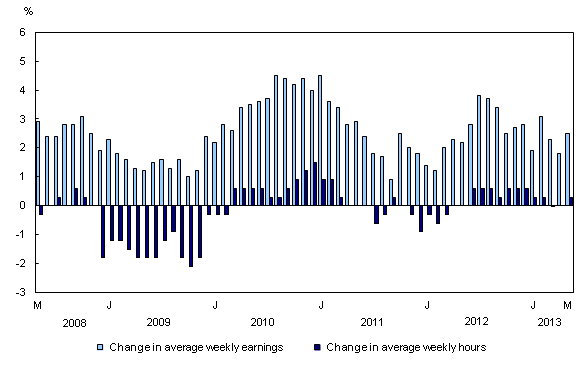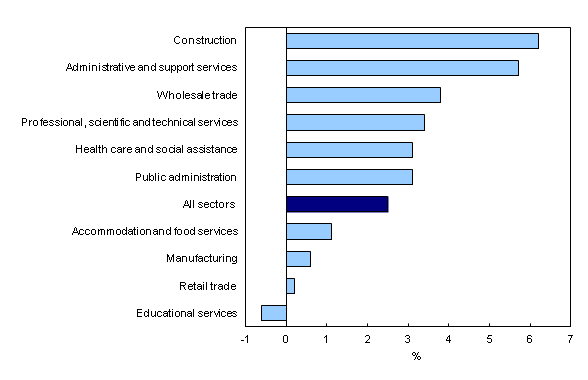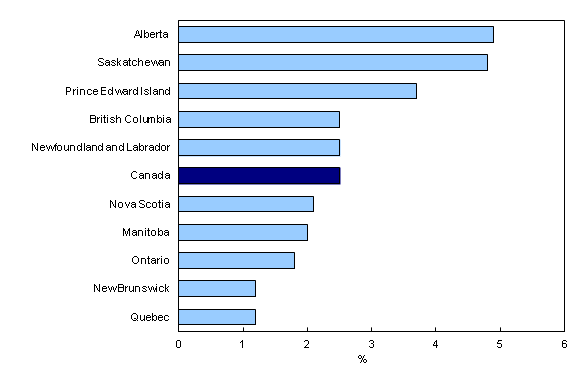Payroll employment, earnings and hours, May 2013
Archived Content
Information identified as archived is provided for reference, research or recordkeeping purposes. It is not subject to the Government of Canada Web Standards and has not been altered or updated since it was archived. Please "contact us" to request a format other than those available.
Released: 2013-07-25
Average weekly earnings of non-farm payroll employees increased 0.9% from the previous month to $915 in May. On a year-over-year basis, earnings rose 2.5%.
The 2.5% increase in weekly earnings during the 12 months to May reflected a number of factors, including wage growth, changes in composition of employment by industry, occupation and level of job experience, as well as average hours worked per week. In May, non-farm payroll employees worked an average of 33.0 hours per week, up from 32.9 hours per week recorded the month before as well as in May 2012.
Average weekly earnings by sector
Year-over-year growth in average weekly earnings outpaced the national average in six of the largest industrial sectors, led by construction as well as administrative and support services.
Average weekly earnings in construction increased 6.2% to $1,201 in the 12 months to May, driven by gains within heavy and civil engineering construction and among speciality trade contractors.
In administrative and support services, average weekly earnings grew by 5.7% to $769, with gains spread across a number of industries within the sector.
Weekly earnings in wholesale trade rose 3.8% to $1,079 in the 12 months to May, with most of the gains since October 2012. Growth over the 12-month period was led by food merchant wholesalers; business-to-business electronic markets, and agents and brokers; and motor vehicle and motor vehicle parts and accessories merchant wholesalers.
In professional, scientific and technical services, weekly earnings increased 3.4% to $1,279. Growth was most notable in legal services; specialized designed services; and in computer systems design and related services.
Compared with 12 months earlier, average weekly earnings in health care and social assistance grew by 3.1% to $825, with most of the gains taking place in the first half of this period. Over the entire 12-month span, the largest earnings increases were in hospitals and in ambulatory health care services.
In public administration, weekly earnings rose 3.1% to $1,177 in the 12 months to May. These gains were mainly the result of notable earnings growth in local, municipal and regional public administration from June 2012 to January 2013.
Weekly earnings in educational services edged down 0.6% to $992 in the 12 months to May, driven by an earnings decline in elementary and secondary schools.
Average weekly earnings by province
Year-over-year earnings growth of non-farm payroll employees was at or above the national average in five provinces, with the highest growth in Alberta and Saskatchewan.
In Alberta, average weekly earnings increased 4.9% to $1,114 in the 12 months to May, with growth across most sectors.
Average weekly earnings in Saskatchewan rose 4.8% to $942, with the growth widespread across a number of sectors.
Compared with May 2012, average weekly earnings in Prince Edward Island increased by 3.7% to $771.
The lowest year-over-year growth was in New Brunswick and Quebec, where earnings increased by 1.2% in each province. In May, average weekly earnings in New Brunswick amounted to $821, and in Quebec, $841.
Non-farm payroll employment by sector
Total non-farm payroll employment was up by 8,500 in May, after a slight decline of 1,100 in April. In the 12 months to May, the number of non-farm payroll employees rose by 117,200 or 0.8%. Employment has been relatively flat since August 2012.
In May, the number of payroll employees increased in health care and social assistance; accommodation and food services; transportation and warehousing; and in retail trade. At the same time, there were declines in construction; manufacturing; and in administrative and support services.
Among all sectors, real estate and rental and leasing posted the highest 12-month growth rate in payroll employment at 3.9%, with most of the gains occurring since December 2012. Growth rates from May 2012 to May 2013 were also notable in accommodation and food services (+3.6%), a sector that has been on an upward trend since early 2011. Construction (+3.1%) was on an upward trend before it declined over the past two months.
Over the same period, there were notable job declines in three sectors. Payroll employment fell 1.7% in information and cultural industries, with the losses spread across a number of industries within the sector. Public administration declined by 1.0%, mostly a result of losses in federal public administration in 2013. At the same time, manufacturing payroll employment was down by 0.9%, with the declines occurring since March 2013.
Collection and estimates in Southern Alberta
Floods in parts of Southern Alberta began during the later stages of the June collection period of May data for the Business Payroll Survey (BPS), the survey component of the Survey of Employment, Payrolls and Hours. Despite this, the Alberta response rate for the May BPS remained high and similar to the Canadian response rate.
Note to readers
The Survey of Employment, Payrolls and Hours (SEPH) is produced by a combination of a census of payroll deductions, provided by the Canada Revenue Agency, and the Business Payrolls Survey, which collects data from a sample of 15,000 establishments. Its key objective is to provide a monthly portrait of the level of earnings, the number of jobs and hours worked by detailed industry at the national, provincial and territorial level.
Estimates of average weekly earnings and hours are based on a sample and are therefore subject to sampling variability. Payroll employment estimates are based on a census of administrative data and are not subject to sampling variability.
Statistics Canada also produces employment estimates from its monthly Labour Force Survey (LFS). The LFS is a household survey, the main objective of which is to divide the working-age population into three mutually exclusive groups: the employed (including the self-employed), unemployed and not in the labour force. This survey is the official source for the unemployment rate and collects data on the socio-demographic characteristics of all those in the labour market.
As a result of conceptual and methodological differences, estimates of changes from SEPH and LFS do differ from time to time. However, the trends in the data are quite similar.
Unless otherwise stated, this release presents seasonally adjusted data, which facilitates comparisons by removing the effects of seasonal variations. For more information on seasonal adjustment, see Seasonal adjustment and identifying economic trends.
Non-farm payroll employment data are for all hourly and salaried employees, as well as the "other employees" category, which includes piece-rate and commission-only employees.
Average weekly hours data are for hourly and salaried employees only and exclude businesses that could not be classified to a North American Industry Classification System (NAICS) code.
All earnings data include overtime pay and exclude businesses that could not be classified to a NAICS code. Earnings data are based on gross taxable payroll before source deductions. Average weekly earnings are derived by dividing total weekly earnings by the number of employees.
With each release, data for the current reference month are subject to revision. Data have been revised for the previous month. Users are encouraged to request and use the most up-to-date data for each month.
A data table is available from the Browse by key resource module of our website under Summary tables.
Data on payroll employment, earnings and hours for June will be released on August 28.
Contact information
For more information, contact us (toll-free 1-800-263-1136; infostats@statcan.gc.ca).
To enquire about the concepts, methods or data quality of this release, contact Emmanuelle Bourbeau (613-951-3007; emmanuelle.bourbeau@statcan.gc.ca), Labour Statistics Division.
- Date modified:




